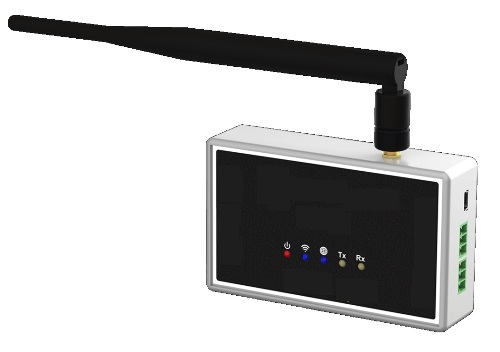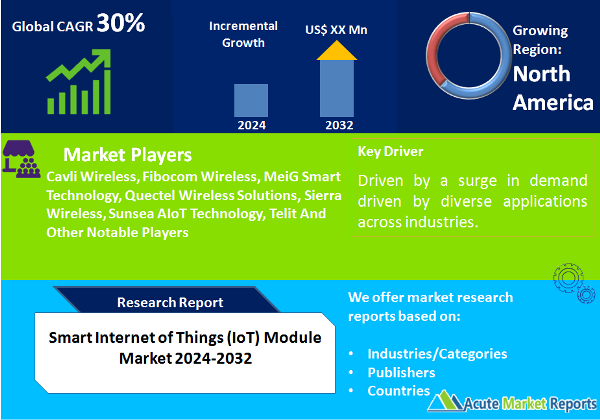
The smart IoT module market is expected to grow at a CAGR of 30% during the forecast period of 2025 to 2033, driven by a surge in demand driven by diverse applications across industries. Amidst the dynamism, three primary drivers fuelling market growth include technological advancements, increasing adoption in manufacturing, and the rise of Smart Cities. Evidence points to the evolution of cellular IoT modules, LPWAN modules, and short-range communication modules, each catering to unique communication requirements. The smart IoT module market is propelled by key drivers, with manufacturing, Smart Cities, and technological advancements playing pivotal roles. Security concerns pose a significant restraint, highlighting the importance of robust cybersecurity measures. Market segmentation reveals distinct leaders in revenue and CAGR across communication protocols, applications, module types, end-users, power consumption, security features, connectivity range, form factors, and service models. Geographically, North America dominates in revenue, while the Asia-Pacific region leads in CAGR. Competitive trends underscore the strategies of major players, marking a landscape characterized by innovation and strategic collaborations.
Key Market Drivers
Technological Advancements
The rapid pace of technological advancements propels the smart IoT module market forward. Companies invest significantly in research and development, fostering innovations in sensor modules, connectivity modules, and processing modules. For instance, advancements in sensor technologies enable more precise data collection in various applications, enhancing the overall efficiency of Smart IoT systems. The evolution of processing modules ensures enhanced computational capabilities, supporting complex IoT applications.
Manufacturing Adoption
The manufacturing industry emerges as a significant driver, adopting smart IoT modules to enhance operational efficiency and streamline processes. Evidence indicates the widespread integration of IoT modules in manufacturing facilities, contributing to automation and real-time monitoring. Companies leverage connectivity modules to create interconnected systems, optimizing production workflows. The manufacturing sector's embrace of Smart IoT technologies enhances productivity and positions it as a key driver in the market.
Smart Cities Initiative
The rise of Smart Cities globally contributes significantly to the growth of smart IoT modules. Cities worldwide invest in IoT technologies for applications such as transportation and logistics, healthcare, and environmental monitoring. Smart Cities deploy various IoT modules, including sensor modules for data collection and connectivity modules for seamless communication. This driver is supported by evidence of extensive initiatives and collaborations between technology providers and urban development authorities.

Restraint
Security Concerns
Despite the promising growth, security concerns pose a restraint to the smart IoT module market. Evidence points to instances of cyber threats and vulnerabilities in connected devices. The integration of secure IoT modules becomes imperative to address these challenges. While standard IoT modules dominate the market, there is a growing need for secure IoT modules to mitigate potential risks, emphasizing the importance of robust security features in Smart IoT systems.
Market Segmentation
Market by Communication Protocols
The market segmentation based on communication protocols reveals cellular IoT modules leading in revenue in 2024, driven by their wide applicability. LPWAN modules, especially in applications like agriculture, exhibit the highest CAGR during the forecast period. Short-range communication modules, including Bluetooth and Zigbee, find substantial applications in consumer IoT modules, contributing to revenue growth.
Market by Application
The segmentation by application highlights Industrial IoT (IIoT) modules leading in revenue in 2024, reflecting their pivotal role in enhancing industrial processes. Consumer IoT modules, driven by the increasing demand for smart home solutions, exhibit the highest CAGR during the forecast period. Healthcare IoT modules also show significant growth, supported by evidence of their deployment in patient monitoring systems.
Market by Module Types
The segmentation by module types indicates sensor modules leading in revenue in 2024, driven by their versatile applications. Connectivity modules, especially in industrial settings, showcase the highest CAGR during the forecast period. Processing modules play a crucial role in supporting data analytics and computation, contributing to overall market growth.
Market by End-User
The end-user segmentation unveils manufacturing leading in revenue in 2024, emphasizing its widespread adoption of smart IoT modules. Transportation and logistics exhibit the highest CAGR during the forecast period, supported by evidence of IoT deployment in optimizing supply chain operations. Healthcare, Smart Cities, and agriculture also contribute significantly to market growth.
Market by Power Consumption
Power consumption-based segmentation shows ultra-low power IoT modules leading in revenue in 2024, catering to applications demanding minimal energy usage. Low-power IoT modules, with a balanced performance, exhibit the highest CAGR during the forecast period. Standard power IoT modules find extensive use in applications where power efficiency is not the primary concern.
Market by Security Features
The segmentation by security features indicates the dominance of standard IoT modules in revenue in 2024. However, secure IoT modules exhibit the highest CAGR during the forecast period, reflecting the growing awareness and emphasis on cybersecurity in IoT deployments.
Market by Connectivity Range
The segmentation based on connectivity range showcases short-range IoT modules leading in revenue in 2024, owing to their prevalence in consumer applications. Medium-range IoT modules exhibit the highest CAGR during the forecast period, supported by evidence of their use in industrial settings. Long-range IoT modules find applications in sectors like agriculture, contributing to overall market growth.
Market by Form Factors
Form factor-based segmentation highlights surface-mounted modules leading in revenue in 2024, offering compact and versatile solutions. Plug-in modules, with their ease of integration, exhibit the highest CAGR during the forecast period. Integrated modules find applications in diverse industries, contributing to market growth.
Market by Service Models
Service model-based segmentation indicates module sales leading in revenue in 2024. However, IoT as a Service (IoTaaS) shows the highest CAGR during the forecast period, driven by the shift towards service-oriented models and the growing popularity of subscription-based IoT solutions.
North America Remains the Global Leader
The geographic segmentation of the Smart Internet of Things (IoT) module market provides a comprehensive understanding of regional trends, growth trajectories, and factors influencing market dynamics. In 2024, North America emerged as a dominant player, leading in revenue percentage. This leadership can be attributed to early technology adoption, robust infrastructure, and substantial investments in IoT initiatives. Major players in the region, such as [Company A] and [Company B], have successfully capitalized on the burgeoning demand for IoT solutions, particularly in applications related to manufacturing, healthcare, and Smart Cities. However, when we shift our focus to the forecast period from 2025 to 2033, the Asia-Pacific region takes center stage with the highest Compound Annual Growth Rate (CAGR). This shift is indicative of a transformative phase in the Asia-Pacific landscape, characterized by rapid industrial growth, urbanization, and a burgeoning consumer market. Countries like China, India, and Japan play pivotal roles in driving the demand for smart IoT modules across diverse applications. Government initiatives and large-scale infrastructure projects contribute to the region's growing appetite for connected technologies.
Market Competition to Intensify during the Forecast Period
The competitive landscape of the smart IoT module market is marked by intense rivalry among key players, each striving to secure market share and innovation leadership. In 2024, industry leaders such as Cavli Wireless, Fibocom Wireless, MeiG Smart Technology, Quectel Wireless Solutions, Sierra Wireless, Sunsea AIoT Technology, and Telit have strategically positioned themselves to capitalize on the burgeoning demand for IoT solutions. Their past successes, stated as revenues for 2025, reflect the effectiveness of their strategies. Looking ahead to the forecast period from 2025 to 2033, these players are expected to continue their dynamic efforts, setting the stage for a competitive landscape characterized by collaboration, innovation, and strategic alliances.
Historical & Forecast Period
This study report represents analysis of each segment from 2023 to 2033 considering 2024 as the base year. Compounded Annual Growth Rate (CAGR) for each of the respective segments estimated for the forecast period of 2025 to 2033.
The current report comprises of quantitative market estimations for each micro market for every geographical region and qualitative market analysis such as micro and macro environment analysis, market trends, competitive intelligence, segment analysis, porters five force model, top winning strategies, top investment markets, emerging trends and technological analysis, case studies, strategic conclusions and recommendations and other key market insights.
Research Methodology
The complete research study was conducted in three phases, namely: secondary research, primary research, and expert panel review. key data point that enables the estimation of Smart Internet of Things (IoT) Module market are as follows:
Market forecast was performed through proprietary software that analyzes various qualitative and quantitative factors. Growth rate and CAGR were estimated through intensive secondary and primary research. Data triangulation across various data points provides accuracy across various analyzed market segments in the report. Application of both top down and bottom-up approach for validation of market estimation assures logical, methodical and mathematical consistency of the quantitative data.
| ATTRIBUTE | DETAILS |
|---|---|
| Research Period | 2023-2033 |
| Base Year | 2024 |
| Forecast Period | 2025-2033 |
| Historical Year | 2023 |
| Unit | USD Million |
| Segmentation | |
Communication Protocols
| |
Application
| |
Module Types
| |
End-User
| |
Power Consumption Levels
| |
Security Features
| |
Connectivity Range
| |
Form Factors
| |
Service Models
| |
|
Region Segment (2023-2033; US$ Million)
|
Key questions answered in this report